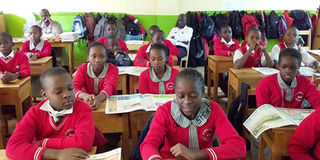Let’s do more on children’s rights, welfare

Pupils of Fesbeth Academy Primary School in Kakamega participate in a literacy session sponsored by NMG's Junior Spot magazine on June 20, 2018. Since the launch of universal free primary education in 2003, there are many more children in school. PHOTO | FILE | NATION MEDIA GROUP
What you need to know:
- Kenya was among the first African countries to ratify the CRC. Since then, we have seen great advances in child rights in the country.
- Today, as long as there are children dying of preventable causes, suffering from malnutrition, not learning, being neglected and abused, silenced and threatened, we all have urgent work to do.
We are approaching an important anniversary this November.
Thirty years ago, world leaders made a historic commitment to the world’s children by adopting the UN Convention on the Rights of the Child (CRC) — an international agreement on nurturing and protecting childhood.
This has helped transform children’s lives around the world, as there was recognition that all children have the right to survival, an identity, development, education, protection, a nurturing environment to grow up in and to be heard.
Kenya was among the first African countries to ratify the CRC. Since then, we have seen great advances in child rights in the country.
Children now benefit from universal free primary education, free health services for under-fives, and improved access to protection services, among other gains.
Much has changed over 30 years. I remember young boys and girls in my home country, Bangladesh, selling wares on the streets to eke out a living, working as porters at train stations, breaking stones with chisels in the scorching sun, fetching water and working in the paddy fields.
IMPROVED HEALTH
I wondered if they ever went to school, what they ate, where they slept and what happened when they fell ill.
I knew it was an unjust world and how important it was to fight for children’s rights and well-being.
Today, as long as there are children dying of preventable causes, suffering from malnutrition, not learning, being neglected and abused, silenced and threatened, we all have urgent work to do.
More children are living beyond their fifth birthdays with improved health outcomes. But significant disparities persist.
Data from the Kenya Demographic and Health Survey 2014 shows that in one part of the country the risk of a child dying before the age of five is five times more than in another part.
Almost all newborn and child deaths are preventable. Kenya’s focus on Universal Health Coverage offers a real opportunity to reach those being left behind.
EDUCATION
Since the launch of universal free primary education in 2003, there are many more children in school.
The introduction of the competency-based curriculum, free day secondary education and push for 100 per cent transition from primary to secondary education can all contribute to an educated young population. Time will reveal the results of these policy decisions.
Access to water and sanitation is another critical issue. According to a report by Unicef and World Health Organisation, 59 per cent of Kenyans had access to drinking water, but just 29 per cent to a basic sanitation service.
This is a public health concern. It puts people, especially children, at the risk of waterborne diseases. Poor health compromises development of children.
The narrative of progress and inequities is also seen in other areas of child well-being such as the birth registration, nutritional status, protection, prevention and treatment of HIV.
As we approach the 30th anniversary of the CRC, I intend to discuss in more detail some of the areas where we can, and must, do better.
The write is the Unicef representative in Kenya; @maniza_zaman




